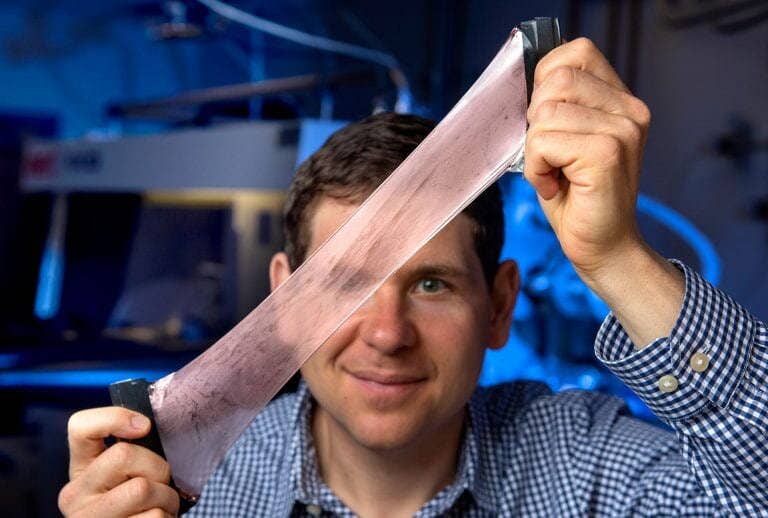Squid skin–inspired material is a game changer for eco-friendly food packaging
They are showing off an adaptive heat-managing composite material they helped develop that is nicknamed after its inspiration: squid skin.

[June 28, 2022: Matt Coker, University of California, Irvine]
Alon Gorodetsky shows off the adaptive heat-managing composite material his lab developed that is nicknamed after its inspiration: squid skin. (Credit: Steve Zylius / UCI)
Inside a lab in the Calit2 building, Aleksandra Strzelecka opens a drawer, pulls out a small square sheet and hands it to a visitor. The brownish, rubbery material stretches to more than double its original size.
"It is very light," notes Panyiming Liu, Strzelecka's fellow graduate student in chemical engineering, and sure enough, were one to hazard a guess on how much it weighs, zero ounces would be a reasonable answer.
They are showing off an adaptive heat-managing composite material they helped develop that is nicknamed after its inspiration: squid skin.
Cephalopod skin allows these creatures to change color, and a UCI invention based on it can insulate beverage cups, restaurant to-go bags, parcel boxes and, if you have enough rolls of it, shipping containers.
Alon Gorodetsky, the associate professor of chemical and biomolecular engineering in whose lab Liu and Strzelecka conduct research, says the idea to pursue packaging applications came during the height of the COVID-19 pandemic, when so many of us ordered groceries and restaurant meals for home delivery.
Related Stories
"Anything that's perishable, anything that needs a controlled temperature comes with an incredible amount of wrapping," Gorodetsky says. "The application was really motivated by thinking about that fundamental problem because food packaging is very wasteful. And the number of packages everyone had delivered to their homes went up by more than an order of magnitude. Where is all that stuff going afterward? It will be in landfills for hundreds of years, basically."
But what traditional food packaging has going for it is the ability to keep hot items hot, cold items cold and the outer shell fairly neutral for easy handling. Which leads us back to the lowly squid. Chromatophore expansion and contraction in a squid's skin alters the reflection and transmission of visible light, and these changes help the cephalopod communicate and camouflage its body to hide from predators.
Gorodetsky's team mimicked this approach by enabling "tunable thermoregulation" in their material, which can lead to improved energy efficiency and even protect sensitive fingers. This is summed up in "Scalable Manufacturing of Bioinspired Materials With Tunable Heat-Managing Properties," the UCI researchers' paper that was published in Nature Sustainability.
The top layer of the material is made of copper and the underlying support layer is a common rubbery polymer. "The composite material can be recycled in bulk by removing the copper with vinegar and using established commercial methods to repurpose the remaining stretchable polymer," says Mohsin Badshah, the paper's lead author and former UCI postdoctoral scholar in chemical and biomolecular engineering.
(Erica Leung, who recently graduated from UCI with a Ph.D. in chemical and biomolecular engineering, is another co-author on the study.)
Showing off the squid skin in the lab, co-authors Liu and Strzelecka explain how the team achieved its goal of making something not only recyclable but nontoxic, antibacterial and very large-scale, while retaining its stretch, strength and temperature-regulation ability.
Cost was another factor, Strzelecka adds. "This material was the best choice for the price," she says. "Some alternatives use gold or silver, but in comparing the price, our approach is more practical to global consumers."
She then pulled out a paper coffee cup with a thin layer of the squid skin-inspired material wrapped around it and held together by Velcro. "You can stretch it to modulate how warm you want your coffee," she said. "One of our experiments was about changing the cooling rate."
Side-by-side thermal infrared camera movies demonstrating the repeated successful mechanical deformation of an enclosure-integrated blanket-like composite with a hand (left) and the repeated attempted mechanical deformation of an enclosure-integrated traditional blanket with a hand (right). Note the substantial change in local apparent temperature induced by the hand for the blanket-like composite. (CREDIT: Nature Sustainability)
"Having something that you can wrap around your cup, like latex or Saran Wrap, would make you able to turn almost any container into an insulated thermos," Gorodetsky says. "But by also being able to stretch the material, you can adjust it to your needs. Maybe you like your coffee burning hot, but someone else likes it warm or lukewarm."
There is obviously much interest in being able to do that, based on the many media outlets that reported on the Nature Sustainability paper, not that the attention surprised Gorodetsky. "The topic is very timely," he says. "Sustainable packing is just one of the things that people are thinking about a lot. There have been some news articles about how Starbucks has been trying to do away with the disposable coffee cup for years because it's such an environmental bane.
Here we demonstrate the scalable manufacturing of squid-skin-inspired sustainable packaging materials with tunable heat-management properties. The reported composites feature a low estimated starting material cost of around US$0.1 m−2, sizes comparable to those of common metallized plastic films, the ability to modulate infrared transmittance by >20-fold and heat fluxes by >30 W m−2 upon actuation with strain, and functional robustness after mechanical deformation or cycling. Furthermore, the composites demonstrate excellent performance in routine practical packaging scenarios, as exemplified by their ability to control the cooling of a model warm beverage within a standard paper container used daily by most adults in the USA. Such materials could represent a technological solution that addresses the combined cost, performance and sustainability pressures facing the food and beverage packaging industry. (CREDIT: Nature Sustainability)
"What did surprise me was the international interest. There are a lot of things regarding sustainability policies happening in places like Italy, Germany and France. I guess that says maybe Europe is a little more forward-thinking than we are in terms of recycling and environmental impact."
What also excites Gorodetsky is the industry interest in the squid skin-inspired materials. "In terms of how we can push this forward, there have been companies contacting Beall Applied Innovation," he says. "That's because we have some intellectual property secured through BAI. That's where I want to give credit to DARPA, who has pushed us toward translation."
He is referencing the Defense Advanced Research Projects Agency, which develops emerging technologies for the military and eventual adaptation for general consumer use. Drones, personal computers, the Internet, voice activation and Moderna's COVID-19 vaccine are among the innovations for which DARPA can claim at least partial credit.
"They think very broadly, which is neat to see," says Gorodetsky, whose lab is benefiting from DARPA's Embedded Entrepreneurship Initiative, which accelerates transformational innovations to products through funding, mentoring, and connecting scientists and engineers to investors and corporate partners.
"They produce technologies that have the potential to create entirely new industries, upend existing markets, establish military advantage, and create lasting societal change," reads an explanation of the initiative's beneficiaries on DARPA's website. "Yet impact is dramatically slowed by a lack of foundational entrepreneurial skills and an insufficient understanding of private-sector market dynamics. The Embedded Entrepreneurship Initiative fills these knowledge gaps by augmenting scientific research teams with critical business expertise."
"We've been in contact with various companies and talking to them about using some of our technologies," says Gorodetsky. "Having that DARPA know-how involved in the process is amazing. There is literally a DARPA-supported entrepreneur embedded in my lab to work with my students to try to translate this technology into products."
Not that it's been easy: The squid skin-inspired material had to compete with other projects to get selected.
"The EEI program is a little over 2 years old, and it is so unique," Gorodetsky says. "We were very lucky to get awarded. The selection process must be mind-blowing because of all the futuristic technologies DARPA sees. Then they go, 'Well, these are the ones that we think are the most promising.' It's very gratifying because it just shows us how far we've come in only a few years after starting from just a concept on paper."
The squid skin-inspired material can be produced for 10 cents per square meter, according to the cost analysis portion of the Nature Sustainability paper. That would make it about as affordable as a space blanket. "We are well within the range for these types of metalized sheets made on standard equipment," Gorodetsky says. "We are slightly on the higher end, but for all intents and purposes, it's basically the same cost as making the inside of a potato chip bag."
The race from research to placement on consumer shelves is not over. "What the embedded entrepreneur is doing now is helping us figure out what will be a marketable and commercially viable product," Gorodetsky says. "We may even make a prototype of that product. Because there are so many different applications, you pick one and make your stand with it.
"The coffee cup example is a cool demonstration, but it may not be the most commercially viable application without a lot more work. That's why you get somebody who has real-world business experience. Someone who will tell you what's what."
What's what for his lab is much more product development—once the exact product is known—and solving additional manufacturing challenges.
"Each time you scale something, that's an entirely new research project," Gorodetsky says. "We want to make rolls of this stuff next. That's an incredible engineering challenge."
Then there is the possibility of modifications being added along the way, such as putting sensors inside the material or adding self-repair capabilities. "There are a lot of bells and whistles that you can add," Gorodetsky says. "But each time you change something, it becomes a whole new project."
Whatever it ultimately becomes, UCI would hold the patent to a valuable material whose future uses seem endless. When it comes to Gorodetsky's lab receiving any proceeds, he humbly submits, "If we get anything, it will be a tiny little bit. And I'll be happy about that. It's a fun, fun project."
And a rewarding one, according to first-time co-author Strzelecka.
"What's interesting is that the measurements we made were completely validated by the theoretical calculations, which tells us the physics behind the idea is really sound," she says. "That's a very good motivator for us to do more studies."
Note: Materials provided above by University of California, Irvine. Content may be edited for style and length.
Like these kind of feel good stories? Get the Brighter Side of News' newsletter.
Joshua Shavit
Science & Technology Writer | AI and Robotics Reporter
Joshua Shavit is a Los Angeles-based science and technology writer with a passion for exploring the breakthroughs shaping the future. As a contributor to The Brighter Side of News, he focuses on positive and transformative advancements in AI, technology, physics, engineering, robotics and space science. Joshua is currently working towards a Bachelor of Science in Business Administration at the University of California, Berkeley. He combines his academic background with a talent for storytelling, making complex scientific discoveries engaging and accessible. His work highlights the innovators behind the ideas, bringing readers closer to the people driving progress.



